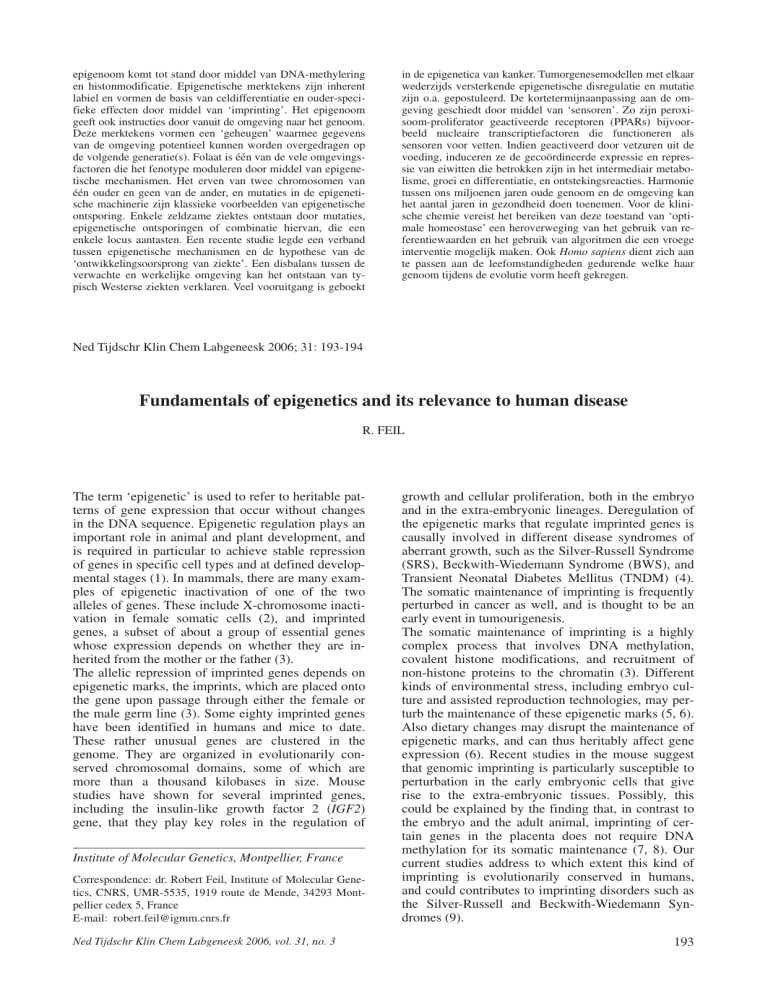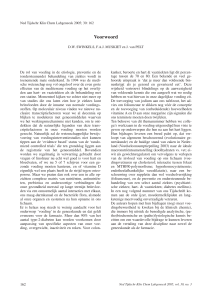
epigenoom komt tot stand door middel van DNA-methylering
en histonmodificatie. Epigenetische merktekens zijn inherent
labiel en vormen de basis van celdifferentiatie en ouder-specifieke effecten door middel van ‘imprinting’. Het epigenoom
geeft ook instructies door vanuit de omgeving naar het genoom.
Deze merktekens vormen een ‘geheugen’ waarmee gegevens
van de omgeving potentieel kunnen worden overgedragen op
de volgende generatie(s). Folaat is één van de vele omgevingsfactoren die het fenotype moduleren door middel van epigenetische mechanismen. Het erven van twee chromosomen van
één ouder en geen van de ander, en mutaties in de epigenetische machinerie zijn klassieke voorbeelden van epigenetische
ontsporing. Enkele zeldzame ziektes ontstaan door mutaties,
epigenetische ontsporingen of combinatie hiervan, die een
enkele locus aantasten. Een recente studie legde een verband
tussen epigenetische mechanismen en de hypothese van de
‘ontwikkelingsoorsprong van ziekte’. Een disbalans tussen de
verwachte en werkelijke omgeving kan het ontstaan van typisch Westerse ziekten verklaren. Veel vooruitgang is geboekt
in de epigenetica van kanker. Tumorgenesemodellen met elkaar
wederzijds versterkende epigenetische disregulatie en mutatie
zijn o.a. gepostuleerd. De kortetermijnaanpassing aan de omgeving geschiedt door middel van ‘sensoren’. Zo zijn peroxisoom-proliferator geactiveerde receptoren (PPARs) bijvoorbeeld nucleaire transcriptiefactoren die functioneren als
sensoren voor vetten. Indien geactiveerd door vetzuren uit de
voeding, induceren ze de gecoördineerde expressie en repressie van eiwitten die betrokken zijn in het intermediair metabolisme, groei en differentiatie, en ontstekingsreacties. Harmonie
tussen ons miljoenen jaren oude genoom en de omgeving kan
het aantal jaren in gezondheid doen toenemen. Voor de klinische chemie vereist het bereiken van deze toestand van ‘optimale homeostase’ een heroverweging van het gebruik van referentiewaarden en het gebruik van algoritmen die een vroege
interventie mogelijk maken. Ook Homo sapiens dient zich aan
te passen aan de leefomstandigheden gedurende welke haar
genoom tijdens de evolutie vorm heeft gekregen.
Ned Tijdschr Klin Chem Labgeneesk 2006; 31: 193-194
Fundamentals of epigenetics and its relevance to human disease
R. FEIL
The term ‘epigenetic’ is used to refer to heritable patterns of gene expression that occur without changes
in the DNA sequence. Epigenetic regulation plays an
important role in animal and plant development, and
is required in particular to achieve stable repression
of genes in specific cell types and at defined developmental stages (1). In mammals, there are many examples of epigenetic inactivation of one of the two
alleles of genes. These include X-chromosome inactivation in female somatic cells (2), and imprinted
genes, a subset of about a group of essential genes
whose expression depends on whether they are inherited from the mother or the father (3).
The allelic repression of imprinted genes depends on
epigenetic marks, the imprints, which are placed onto
the gene upon passage through either the female or
the male germ line (3). Some eighty imprinted genes
have been identified in humans and mice to date.
These rather unusual genes are clustered in the
genome. They are organized in evolutionarily conserved chromosomal domains, some of which are
more than a thousand kilobases in size. Mouse
studies have shown for several imprinted genes,
including the insulin-like growth factor 2 (IGF2)
gene, that they play key roles in the regulation of
Institute of Molecular Genetics, Montpellier, France
Correspondence: dr. Robert Feil, Institute of Molecular Genetics, CNRS, UMR-5535, 1919 route de Mende, 34293 Montpellier cedex 5, France
E-mail: [email protected]
Ned Tijdschr Klin Chem Labgeneesk 2006, vol. 31, no. 3
growth and cellular proliferation, both in the embryo
and in the extra-embryonic lineages. Deregulation of
the epigenetic marks that regulate imprinted genes is
causally involved in different disease syndromes of
aberrant growth, such as the Silver-Russell Syndrome
(SRS), Beckwith-Wiedemann Syndrome (BWS), and
Transient Neonatal Diabetes Mellitus (TNDM) (4).
The somatic maintenance of imprinting is frequently
perturbed in cancer as well, and is thought to be an
early event in tumourigenesis.
The somatic maintenance of imprinting is a highly
complex process that involves DNA methylation,
covalent histone modifications, and recruitment of
non-histone proteins to the chromatin (3). Different
kinds of environmental stress, including embryo culture and assisted reproduction technologies, may perturb the maintenance of these epigenetic marks (5, 6).
Also dietary changes may disrupt the maintenance of
epigenetic marks, and can thus heritably affect gene
expression (6). Recent studies in the mouse suggest
that genomic imprinting is particularly susceptible to
perturbation in the early embryonic cells that give
rise to the extra-embryonic tissues. Possibly, this
could be explained by the finding that, in contrast to
the embryo and the adult animal, imprinting of certain genes in the placenta does not require DNA
methylation for its somatic maintenance (7, 8). Our
current studies address to which extent this kind of
imprinting is evolutionarily conserved in humans,
and could contributes to imprinting disorders such as
the Silver-Russell and Beckwith-Wiedemann Syndromes (9).
193
Literature
1. Jaenisch R, Bird A. Epigenetic regulation of gene expression: how the genome integrates intrinsic and environmental signals. Nature Genet 2003; 33 (Suppl): 245-254.
2. Avner P, Heard E. X-chromosome inactivation: counting,
choice and initiation. Nature Rev Genet 2001; 2: 59-67.
3. Delaval K, Feil R. Epigenetic regulation of mammalian genomic imprinting. Curr Opin Genet Dev 2004; 14: 188-195.
4. Delaval K, Wagschal A, Feil R. Epigenetic deregulation of
imprinting in congenital diseases of aberrant growth.
Bioessays 2006; 28: 453-459.
5. Khosla S, Dean W, Reik W, Feil R. Culture of pre-implantation embryos and its long-term effects on gene expression
and phenotype. Human Reprod Update 2001; 7: 419-427.
6. Arnaud P, Feil R. Epigenetic deregulation of genomic
imprinting in human disorders and following assisted
reproduction. Birth Defects Res, Part C (Embryo Today)
2005; 75: 81-97.
7. Umlauf D, Goto Y, Cao R, Cerqueira F, Wagschal A, Zhang
Y, Feil R. Imprinting along the Kcnq1 domain on mouse
chromosome 7 involves repressive histone methylation and
recruitment of Polycomb group complexes. Nature Genet
2004; 36: 1296-3000.
8. Lewis A, Mitsuya K, Umlauf D, Smith P, Dean W, Walter J,
Higgins M, Feil R, Reik W. Imprinting on distal chromosome 7 in the placenta involves repressive histone methylation independent of DNA methylation. Nature Genet 2004;
36: 1291-1295.
9. Monk D, Arnaud P, Apostolidu S, Hills FA, Kelsey G,
Stanier P, Feil R, Moore GE. Limited evolutionary conservation of imprinting in the human placenta. Proc Natl Acad
Sci USA 2006, 103: 6623-6628.
Ned Tijdschr Klin Chem Labgeneesk 2006; 31: 194-195
The epigenetic basis of the developmental origins of health and disease
M.A. HANSON, K.A. LILLYCROP, A.A. JACKSON and G.C. BURDGE
One mechanism by which maternal diet during pregnancy may lead to stable changes in gene expression
within the offspring is through the altered epigenetic
regulation of genes. Epigenetic processes stably alter
gene activity without altering gene sequence. The two
major epigenetic mechanisms are DNA methylation
and histone modification. Methylation of CpG rich
clusters (termed CpG islands) which span the promoter regions of genes is associated with transcriptional repression, while hypomethylation of CpG
islands is associated with transcriptional activation
(1-4). These methylation patterns are largely established in utero. We have shown for the first time that
feeding pregnant rats a protein-restricted (PR) diet
alters promoter methylation patterns in a gene-specific manner in the offspring (5). We found decreased
methylation of the 5’ region of the PPARα (20%)
promoter and glucocorticoid receptor (GR) 110 promoter (23%) genes in the liver after weaning of the
Developmental Origins of Health and Disease Division,
University of Southampton, UK
Correspondence: prof. dr. Mark A. Hanson, Centre for Developmental Origins of Health and Disease, University of Southampton, Princess Anne Hospital Level F (887), Coxford
Road, Southampton S016 5YA, UK
E-mail: [email protected]
194
offspring from dams fed a PR diet during pregnancy
(5). Hypomethylation of the 5’ CpG islands in the
promoters of GR and PPARα correlates with the
increase in expression of these genes that we previously observed. These epigenetic changes were associated with increased expression of acyl-CoA oxidase
(AOXa) (5), the rate-limiting enzyme in peroxisomal
fatty acid β-oxidation and with dyslipidemia (6).
Supplementation of the PR diet with folic acid prevented these epigenetic changes in GR and PPARα
expression, and normalised AOX expression (5).
Thus altered gene methylation may provide a causal
mechanism to explain how maternal diet can stably
reset gene expression within the offspring.
Histone modification, like DNA methylation, can
also affect gene activity. In each cell, DNA is
wrapped around a core of histone proteins (H2A.
H2B, H3 and H4), in general acetylation of specific
amino acid residues in histone proteins causes a
decrease in the strength of interaction between DNA
and histones which facilitates access to gene promoters by the transcription machinery (7). Prenatal
under-nutrition also induced hyperacetylation of histone H3 and H4 at the GR (8). Together these data
reveal, for the first time, a causal molecular mechanism linking impaired fetal nutrition with long-term
modification of the phenotype of the offspring.
Supported by the British Heart Foundation
Ned Tijdschr Klin Chem Labgeneesk 2006, vol. 31, no. 3












